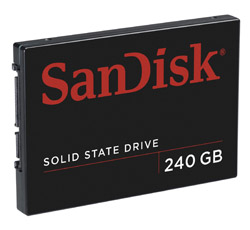SanDisk boosts speed, lowers price of SSDs

SanDisk announced today a new line of SSDs that not only offer larger capacities but, according the company, are twice as fast as competing SSDs that have hit the market in the past year (which are themselves already significantly faster than standard hard drives on many tasks).

Like most laptop SSDs, SanDisk G3 series is based on less-costly MLC (Multi-Level Cell) NAND flash. The drawback to MLC is that its performance and endurance is inferior to the pricey SLC NAND in enterprise-class SSDs. In this case, however, SanDisk is promising some big performance numbers--sequential read performance of 200MB per second and sequential write performance of 140MB per second. That's twice as fast as most SSDs and five times faster than a 7,200rpm hard drive, SanDisk says. Intel's 80GB X18-M and 160GB X25-M SSDs--which are generally regarded by reviewers as the top performers--have a maximum read speed of 250MB per second but a write speed of 70MB per second.
Why are the SanDisk drives so fast? SanDisk says it has to do with several new technologies: its ExtremeFFS file system; 43nm NAND flash using a different design known as an all bit-line (ABL) architecture; and SanDisk's latest controller.
To date, netbooks have been driving the SSD market. SanDisk and several others offer PATA-based drives at lower densities for this market. Earlier this week SanDisk announced its second generation of these modular drives for netbooks in 8-, 16-, 32- and 64GB capacities. But the comany thinks pricing has finally reached an "inflection point" where higher-density laptop SSDs will be competitive. If these lower-priced SSDs can really deliver on the promises of faster booting, quicker application launching and longer battery life, they could start to catch on. That would be a welcome development for an industry awash in excess NAND flash chips. As SanDisk Chairman Eli Harari said at the press conference, "demand creation is job one for the industry."